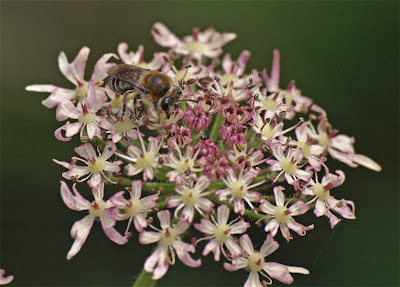A Painted Lady today in suburban Stevenston was the only one I've seen this year. A couple of Small Coppers were on the Ardeer Brownfield land at Garnock West and 3 Small Heaths were at Bogisde Racecourse.
Iain
Thursday 9 September 2010
Saturday 10 July 2010
June at Ardeer
With solitary bees and wasps the focus of my attention, I wasn't very conscientious with regard to butterfly counts. However, on the 26th June I made a count of 69 Dark Green Fritillaries on the Ardeer Peninsula. The biggest surprise though was when a suspiciously small fritillary which I quickly netted as it flew past turned out to be a Small Pearl-bordered Fritillary. Literally hundreds of Ringlets too and mind-boggling numbers of Six-spot Burnet Moths.
It will take a long time to ID all of my bees and wasps under the microscope. However, below are a few pictures of ones that are already ID'd.

It will take a long time to ID all of my bees and wasps under the microscope. However, below are a few pictures of ones that are already ID'd.
Chrysis ruddi - a Cuckoo Wasp
Nomada marshamella - a 'cuckoo' solitary bee
Anthophora furcata - a solitary bee
Coelioxys elongata - a cuckoo of leafcutter bees
Ectumnius contunuus - a digger wasp
Hedychridium ardens - a Cuckoo Wasp
Colletes floralis - a solitary bee

Nomada marshamella - a 'cuckoo' solitary bee

Anthophora furcata - a solitary bee

Coelioxys elongata - a cuckoo of leafcutter bees

Ectumnius contunuus - a digger wasp

Hedychridium ardens - a Cuckoo Wasp

Colletes floralis - a solitary bee

Saturday 8 May 2010
First Small Heath
Whilst out walking in the Rankinston area this afternoon I saw my first Small Heath of the year (this is the second earliest date on which I have ever recorded this species), other butterflies seen in the area were 22 Green-veined Whites, 7 Orange Tips and 1 Peacock. This morning I also saw 3 Green-veined Whites, 1 Orange Tip and 2 Peacocks near Sinclairston.
Sunday 25 April 2010
Green-veined Whites
I saw my first 4 Green-veined Whites of the year yesterday flying near Coylton bowling green, I also saw a Peacock yesterday and 2 Peacocks and a Small Tortoiseshell today in the Rankinston area.
Thursday 22 April 2010
Emperor Moth

Have you seen an Emperor Moth in Ayrshire?
Emperor Moths are superb creatures that are emerging now and can be found in many habitats including hedgerows, but especially on the moors. You can find them sitting on top of heather for instance until the end of May. We have only 20 sightings for Ayrshire recorded and would like to find out more about it's distribution.
Friday 16 April 2010
Cinnabar Moth Survey 2010



This survey, which began last year, is continuing through 2010.
Like many of the commoner moths, the Cinnabar has undergone a long-term decline in recent decades (83% over 35 years, based on Rothamsted trap data) and at the UK level is now regarded as a vulnerable species (see ‘The State of... Britain’s Larger Moths’ report). It remains widespread across England & Wales, but is much scarcer in Scotland, where it is most often seen in coastal areas. Butterfly Conservation, with support from the Moths Count team, wants to learn more about where it occurs and this is most easily done by spotting the colourful orange and black caterpillars which feed on ragwort leaves, often in such large numbers that they strip the plants completely. The caterpillars can be seen in July and August; the equally striking adult moth has a long flight season, starting in late May and, because it is easily disturbed during the day and will fly when it’s sunny, may also be recorded during the same period.
Postcards showing both the larva and adult were widely distributed in 2009 and further publicity is planned for this year. People are being asked to send in any sightings using either the postcards or directly by e-mail to Barry Prater , the Moth Recorder for Berwickshire.
There was a pleasing response from BC members and others and the map shows all the 2009 records received; if you know of more from last year do please send them in.
One of the objectives of the survey is to highlight the issue of moth conservation in the context of the overall pressure on biodiversity. The reliance of Cinnabar larvae on the widespread but controversial plant ragwort, known to be toxic to horses, may raise conflicts of interest, but a very helpful leaflet ‘Ragwort Friend or Foe’, prepared jointly by Butterfly Conservation, Plantlife and the British Horse Society is available from the BC Scotland page of the main BC website. The leaflet outlines the benefits and problems of ragwort and gives advice on its management.
Anyone who lives here or others who visit the area during the summer can help by taking part in the survey.
Wednesday 17 March 2010
First bumblebees in Monktonhill
I know it is slightly outside the normal scope of this site, but I saw my first bumblebees in our garden at Monktonhill today. I only got close to one (out of at least three), and that appeared to be the usual Bombus terrestris.
We still have 11 Small Tortoiseshells hibernating in our porch.
Roger Hissett
We still have 11 Small Tortoiseshells hibernating in our porch.
Roger Hissett
Friday 12 March 2010
First butterfly of the year
Earlier this morning I saw my first butterfly of 2010, it was a Small Tortoiseshell fluttering between a handful of Dandelions in the lovely sunshine near the former location of Littlemill Colliery just outside Rankinston.
Subscribe to:
Posts (Atom)








